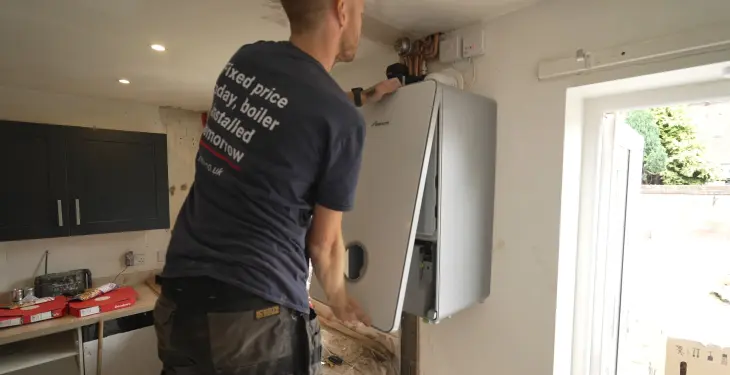

Written by Stephen Day
Gas Safe Engineer
Updated: 30th May, 2025
Radiators come in various types and materials, offering different benefits. Choosing the right one for your home depends on your specific needs and style preferences.
Get a new boiler quote, save up to £550 per year (0% APR available).
Radiators are a vital part of any UK home, impacting both comfort and energy efficiency. With numerous types available, choosing the right one can be daunting. From conventional models to stylish column designs, each option offers unique benefits. Selecting the right type of radiator for your home can enhance both its aesthetic and functional appeal. Understanding their differences can help homeowners make informed decisions for their heating needs.
Panel radiators, such as Type 11 and Type 22, are popular choices for central heating systems. They are designed to suit various room sizes while offering efficient heat distribution. On the other hand, column radiators blend traditional design with modern performance, making them a stylish choice for many. For bathrooms, towel radiators not only provide warmth but also help keep towels dry.
In addition to aesthetics and functionality, safety and space considerations play important roles. Low surface temperature radiators are ideal for homes with children or elderly people, providing safe and effective heating. Skirting board radiators and underfloor heating options offer efficient solutions for saving space while maintaining warmth. With such diverse choices, homeowners can find options that meet various needs and preferences.
Get a quote in 60 seconds, fitted as fast as next day!
0% APR finance available.
Radiators come in various types and materials, offering different benefits. Choosing the right one for your home depends on your specific needs and style preferences.
These radiators save space and can be an elegant addition to modern homes. They are perfect for narrow wall spaces.
Widely used and suitable for most rooms. They provide even heat distribution.
Featuring creative and decorative designs, they add a touch of style. Options include mirror radiators and those with unique shapes.
Aluminium Radiators: They heat up quickly and are lightweight. Ideal for those who want efficiency.
Stainless Steel Radiators: Known for durability and a sleek look.
Mild Steel Radiators: Commonly used due to their affordability.
Plumbed Radiators: Connected to the central heating system.
Electric Radiators: Plug into an electrical outlet, offering flexibility.
Radiator Covers can be used to enhance aesthetics and safety, although they might reduce heat output slightly.
Consider the radiator’s size and colour to ensure it matches your room. Floor-standing options are also available for those with specific design needs.
Selecting the best radiator depends on room size, design preferences, and heating requirements. Consult a heating specialist if unsure, ensuring that your choice maximises both style and efficiency.
Choosing the right radiator can affect both comfort and efficiency. Conventional radiators, often seen in older homes, use convection to circulate warm air. These radiators are connected to central heating systems and generally consist of multiple columns which provide a classic look.
In contrast, panel radiators offer a more modern style. They have flat panels and are often slimmer, making them a good fit for contemporary interiors. They can also work with central heating systems, providing a similar level of warmth while taking up less space.
Convection Efficiency:
Conventional Radiators: Use natural convection, relying on the columns to circulate air. Suitable for rooms where fast and even heating is desired.
Panel Radiators: Also use convection but tend to heat up quicker due to their flat design. More efficient in rooms with limited space.
Design Preferences:
Conventional: Aesthetic appeal with traditional decor. They can be larger and might occupy more space.
Panel: Sleeker and minimalist appearance. Ideal for modern settings.
Both types offer reliable heating for homes. While panel radiators might suit a modern or small area, conventional radiators can enhance a room with a traditional touch. Consider the room size, design, and heating needs to find the best fit.
Towel radiators offer a clever way to keep your bathroom warm while also providing a cosy towel experience. These appliances can be mounted on the wall, which is great for saving space, especially in smaller bathrooms. As a result, they are a popular choice in many UK homes.
Types of Towel Radiators:
Standard Heated Towel Rails: These use the central heating system to warm up. They are a reliable option and efficient during cold months when the heating is on frequently.
Electric Towel Rails: These operate independently of the central heating. They allow you to warm towels without turning on the entire system, providing flexibility in warmer months.
Dual Fuel Radiators: These combine two functions. They can run on both central heating and electricity, offering year-round comfort. This can be useful when you need warmth outside the usual heating season.
Towel radiators are a valuable addition if you're looking to avoid damp towels and want a bit of extra warmth in the bathroom. They help maintain a pleasant atmosphere and are useful for preventing mould, especially in wetter conditions.
Cost Considerations:
The price range for a heated towel rail varies. Typically, you can expect to spend between £150 – £200. Installation costs may be higher for dual fuel options.
Selecting the right type depends on personal preference, available space, and budget. Each option provides its own benefits, making towel radiators an appealing feature for any bathroom.
Column radiators offer a perfect blend of style and function, making them a favourite in traditional homes across the UK. With their tall, vertical columns, they fit seamlessly into period properties while efficiently heating rooms.
Materials: These radiators often come in durable cast iron or steel, each providing reliable warmth. Cast iron radiators are particularly appreciated for their heat retention, slowly releasing warmth even after the heating is turned off.
A column radiator can feature between two and four columns, allowing for various levels of heat output. This makes them adaptable to different room sizes and heating needs.
Design: Inspired by Victorian-era styles, column radiators complement classic interiors.
Versatility: Available in multiple sizes and column numbers, these radiators suit diverse spaces.
Heating Efficiency: Both cast iron and steel options offer powerful performance.
These radiators are not only functional but also add a decorative element to a home. They come in a range of finishes and colours, allowing homeowners to tailor the look to their personal style.
In summary, column radiators remain a timeless choice for those looking to maintain a traditional aesthetic while enjoying modern heating efficiency.
Low Surface Temperature (LST) radiators are becoming increasingly popular for their safety features. They operate at a surface temperature that does not exceed 43°C. This feature makes them ideal for places like schools, hospitals, and care homes where contact with hot surfaces poses a risk.
Traditional radiators can get as hot as 75°C or more. This temperature can cause burns if touched accidentally. In environments with vulnerable individuals, using LST radiators reduces the risk of accidents significantly.
LST radiators offer a safer option, especially in places frequented by children or the elderly. These radiators meet strict safety standards set by UK regulations to ensure they are suitable for public use.
Beyond safety, installing LST radiators can also promote peace of mind for facility managers and residents alike. Knowing that radiators won't cause burns can ease concerns in high-traffic areas.
In healthcare settings, LST radiators can be essential. Hospitals and clinics benefit from their safety standards, making them suitable for patient rooms, waiting areas, and even bathrooms.
Due to these features, LST radiators have become a preferred choice in various environments. Their design ensures that while they provide warmth, they also protect those in the vicinity from harm. This balance of functionality and safety makes LST radiators an important consideration in many buildings.
Skirting board radiators are a clever solution for those looking to save room space. Unlike traditional radiators, they are integrated into the skirting boards along the walls. This means they don't take up ground or wall space, making them perfect for smaller areas or rooms with lots of furniture.
These radiators deliver heat efficiently by spreading warmth from the ground up. The heat distribution is even, ensuring the entire room gets warm without cold spots. This method can be as effective as conventional radiators, maintaining a cosy environment throughout the space.
Types of Skirting Board Radiators:
Electric Systems: Quick, easy installation and ideal for spaces not connected to a central heating system.
Water-Based Systems: Require piping and are connected to the home's central heating. Suitable for consistent heating needs.
The installation might involve some effort, especially for water-based systems. However, the convenience of having heating integrated into skirting boards can be a worthy investment for many homes. They provide a clean look that doesn’t interrupt the room’s design, which can greatly enhance aesthetic appeal.
These radiators combine style and functionality, offering a solution that doesn't compromise on heat output while saving valuable space.
Underfloor heating (UFH) transforms floors into large radiators. It uses either water-filled pipes or electric elements. This offers more even heat distribution than traditional wall-mounted radiators.
Radiators, found throughout homes in the UK, include electric and oil-filled types. Electric radiators are easy to install but may have higher running costs. Oil-filled radiators are often portable and retain heat longer.
Energy Efficiency: Underfloor heating operates at lower temperatures. This can lead to potential savings on energy bills. Radiators, especially older models, may not be as efficient.
Comfort: UFH provides consistent warmth. Feet feel warm, heat rises evenly. Radiators might leave cold spots, especially in larger rooms.
Space and Aesthetics: With underfloor systems, there's no need for visible units. Radiators, while varied in design, can take up wall space.
Installation and Cost: Installing UFH can require a substantial upfront investment and floor alterations. Radiators are easier to fit or replace, often at a lower initial cost.
Longevity: UFH systems generally have a longer lifespan. Radiators may suffer from issues like rust and need replacement more frequently.
Choosing between underfloor heating and radiators will depend on individual needs, home design, and budget. Each system comes with its benefits and drawbacks, making the decision primarily a matter of personal preference and specific requirements.
Single Panel Radiators are typically less expensive to buy and operate. They work well in small spaces, providing a sleek and modern look as they protrude less from the wall. These radiators consist of one metal panel with convector fins, making them light and easy to install.
In contrast, Double Panel Radiators are more efficient for larger areas. They have two panels, often with additional metal fins in between, which increases the surface area for heat output. This design makes them more powerful at heating larger spaces quickly.
A table comparison can help illustrate these differences:
Feature | Single Panel Radiators | Double Panel Radiators |
Cost | Lower | Higher |
Heat Output | Lower | Higher |
Installation | Easier | More complex |
Ideal for | Small rooms | Large rooms |
Visual Appearance | Sleek | Bulkier |
When choosing between the two, consider room size and heating needs. Double panel radiators provide more warmth, but single panels are ideal for smaller budgets and spaces. Each type has its own advantages depending on these factors.
Type 22 radiators are a popular choice for living rooms in the UK. They boast a high heat output and efficiency which is ideal for medium to large-sized rooms. This model features two panels and two sets of convector fins, allowing them to produce more heat compared to other types, such as the Type 21.
One of the main advantages is their compact design. Despite their efficiency, Type 22 radiators do not take up excessive space. They fit well in most living room layouts, making them ideal for spaces where both performance and aesthetics matter.
Installation of a Type 22 radiator is straightforward, much like other types of radiators. Many models come with flexible installation options, offering homeowners the ability to position them in various spots in the room. This adaptability ensures they meet different heating needs and preferences.
Energy efficiency is another key factor. Type 22 radiators can rapidly heat up a living room, reducing the need for prolonged heating. This makes them a cost-effective choice for those looking to maintain a comfortable environment without excessive energy bills.
Aesthetically, they come in various styles and finishes, from sleek white models to more decorative designs. This variety allows them to complement numerous interior designs, providing both functionality and visual appeal.
In summary, a Type 22 radiator offers efficient and powerful heating, making it a solid option for living rooms. With flexibility in design and installation, it suits various home setups and preferences.
Type 11 Radiators are known for their slim design. They have a single panel and one set of fins. Because they are thinner, they fit well in smaller spaces. However, their heat output is generally lower compared to larger types.
Type 22 Radiators, on the other hand, feature two panels and two sets of fins. This design offers a higher heat output, making them suitable for larger rooms needing more warmth.
Efficiency depends on how well the radiator can distribute heat while using less energy. Type 22 radiators tend to be more energy-efficient because they warm up spaces faster and maintain a consistent temperature.
In colder climates or larger spaces, Type 22 Radiators are often preferred for their higher efficiency and ability to heat effectively. Type 11 Radiators may suffice in less-demanding settings.
Here’s a simple comparison for clarity:
Radiator Type | Panels | Fins | Heat Output | Space Suitability |
Type 11 | 1 | 1 | Lower | Smaller rooms |
Type 22 | 2 | 2 | Higher | Larger rooms |
Choosing the right radiator type depends on the specific heating needs and room size. Both options have their strengths, so consider what balances efficiency and comfort for your space.
Choosing the correct radiator size is crucial for maintaining comfort and keeping energy expenses low. An oversized radiator can lead to wasteful energy use, while one too small might not heat the room effectively, causing higher bills.
To start, calculate the necessary British Thermal Units (BTU) using a BTU calculator. This helps you determine the appropriate output for your room size. Consider factors like the room's insulation, number of windows, and ceiling height, as these affect heat requirements.
A handy rule of thumb is to allocate approximately 100 watts per square metre. However, each space has its unique needs. Consult a radiator buying guide for recommendations tailored to your specific conditions.
Check the BTU outputs of radiators before making a purchase. Manufacturers often provide a range of options based on wattage. Match the radiator's BTU capacity with your calculated requirement to ensure you choose a suitable model.
Consider the cost implications of your choice. While initially cheaper radiators might save money, they could result in higher energy bills if they aren’t efficient. Investing in a more efficient radiator can lead to savings in the long term.
When comparing different radiator types, take note of their styles, as you'll want one that fits your room's décor while meeting practical needs. With the correct size and type, you can achieve a balance between comfort and cost-effectiveness.
Thermostatic Radiator Valves (TRVs) can make a significant difference in energy efficiency. These devices are attached to radiators and allow control of room temperatures individually. By adjusting the flow of hot water through each radiator, TRVs ensure that energy is not wasted heating rooms that are not in use.
How do TRVs work? They automatically regulate the temperature by letting in only the needed amount of hot water. This smart management means you can maintain comfort without overusing energy.
Using TRVs can lead to savings on energy bills. Radiators only heat the spaces required and reduce overall fuel consumption. Studies and user experiences often point to noticeable reductions in heating costs after installing TRVs.
Installation and Management: TRVs are not expensive. Prices range from around £10 to £30. They provide a great return on investment by reducing heating costs over time. For even greater control, smart TRVs can be managed remotely using smartphone apps.
These devices are especially beneficial in the UK climate, where the temperature can vary greatly from one day to the next. Controlling radiators with TRVs helps maintain a stable indoor climate, improving comfort while cutting energy use.
Including TRVs in your home heating system is an effective strategy to enhance energy efficiency. Whether opting for standard or smart versions, TRVs provide flexibility and efficiency, making them a wise choice for reducing energy consumption.
Get a quote in 60 seconds, fitted as fast as next day!
0% APR finance available.
Last updated: 30th May, 2025

Written by Stephen Day
Gas Safe Engineer at iHeat
Stephen Day is a Gas Safe registered and FGAS certified engineer with over 20 years of hands-on experience in the heating, cooling, and renewable energy industry, specialising in boiler installations, air conditioning, and heat pump systems.
LinkedInArticles by Stephen Day are reviewed by iHeat’s technical team to ensure accuracy and reliability.

22nd December, 2025
Based on data from over 7000 boiler installations completed by iHeat in the past 12 months...
 Read Article
Read Article

22nd December, 2025
Here’s a quick roundup of the best combi boilers for 2026.
 Read Article
Read Article

22nd December, 2025
When your old boiler breaks down and it comes time to replace it with a new one, it might...
 Read Article
Read Article
No obligation. Takes less than 60 seconds.